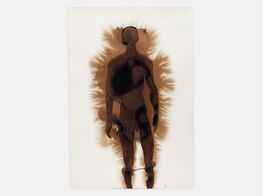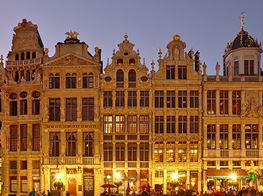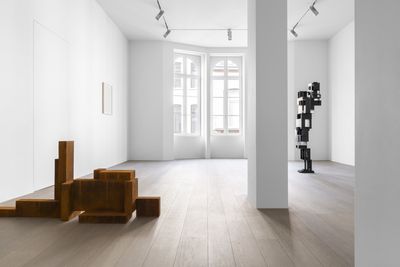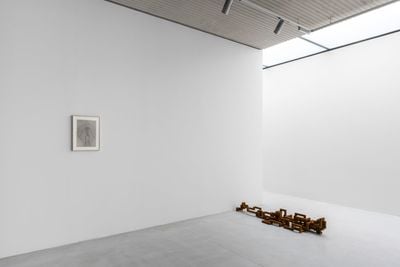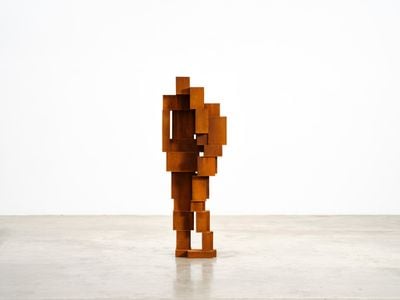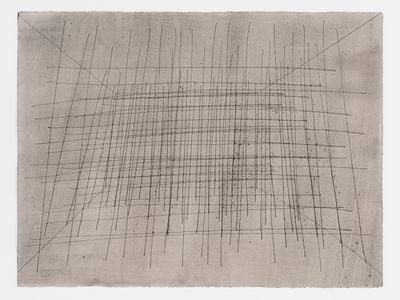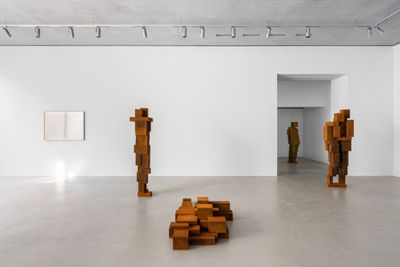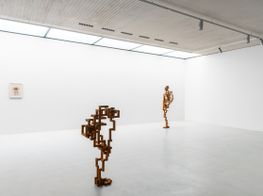
In 1987, Xavier Hufkens was just 21-years-old when he asked Antony Gormley to inaugurate his debut gallery space on Rue de l'Église in Brussels. Featuring three unique sculptures; a lead, fibreglass, and plaster figure, alongside two abstract forms, the show was just the beginning of a lifelong partnership.
Thirty-five years on, and we arrive at BODY FIELD (28 October–17 December 2022), Gormley's ninth show with the gallery, and his first at Hufkens' new and expanded St-Georges space in Brussels.
Testament to Gormley's unwavering commitment to the extended body as, first and foremost, a site of architecture, BODY FIELD is both a continuum, yet evolution on the last.
We find the familiar—a selection of his ongoing 'Knotwork' sculptures, and Run III, a 153-metre-long steel cast tube (which he assures is 'probably the best of the three')—alongside a new series of cast iron double sculptures, entitled 'Double Blockworks'.
As BODY FIELD comes into its final week, we sit down with Gormley at his imposing David Chipperfield-designed studio in London's King's Cross to discuss the impetus of his Brussels show, and the important lesson of symbiosis that drives his creative process.
Congratulations on this milestone—nine shows and thirty-five years working with Xavier.
Working together all this time, how do the two of you go about planning a show? Are you struck by any specific development in your approach to a show when you look back to the first?
I am really familiar with Xavier's gallery. While my very first show with him was at his space on Rue de l'Église, the following seven were at his St-Georges gallery, so I got to know the space very well and it became pertinent to my work.
While the planning of each show is serendipitous, in that whatever you're working on at the time has this chance of a platform, I am very conscious of my work's relationship to domestic architecture, and the scale of domestic architecture.
His gallery was first and foremost a house, to which a gallery extension was built on. Now, the gallery extension has been demolished and rebuilt at a scale that actually redetermines the house. The house becomes the annex of the gallery.
So if like me, you're interested in enquiring into the body as our first domicile, and architecture as the second, it actually helps that the gallery has that relationship to actual living space.
BODY FIELD is only the third show at Hufkens' new and expanded St-Georges gallery—an uber-contemporary space with phenomenal light, and large-scale concrete rooms—and I read somewhere that, to an extent, you were the impetus for building this new space.
What influence has this had on the works you've made, and your curation of the show?
I start very much with the gallery in mind. I hadn't seen the new extension when we were planning for the show, so before committing to our decisions, I had to go check, go smell, go taste the space.
Run III—the first work you come across in the exhibition—is absolutely made in response to the actual dimension, scale, materiality, and light of the new ground-floor gallery. A steel square tube wraps the dimensions of the room, questioning where our surroundings begin and end and the notion of the inside, outside, the threshold to wall, and window to ceiling.
In life we are continually given choices, yet ruled by those choices, those affordances, that are offered to us by our constructed world. This sculpture both confuses and makes present this concept. It formulates a kind of choreography, self-consciousness, or proprioception of the viewer as they move around the space.
You've debuted a new series of work, 'Double Blockworks', which are casts based on scans of your body clasping an existing blockwork. What is the idea behind this new series?
These double works are an attempt to say, the body is a place before it's an object.
One of the things that came out of lockdown was this sense that the familiar body of your lover, or the person that you were living with, was part of that place you live in, but also an extension of yourself.
These works were born out of a resistance to values associated with the sovereign self and individualism. When we say we are close to somebody, it's both a metaphor and literal: about a shared sense of ease in a shared imaginative space. These sculptures acknowledge that there is an osmosis that happens when we share a sense of ease, even in silence, of just enjoying the same air.
You could say these sculptures are conceptual, formal, process-oriented, material-based. It is all those things, but it is also something else. In a time where we have the rebooting of war and human difference, these images of closeness are a sign of hope and infer that there are ways of being together that is neither about conflict, nor sexual desire, but simply about sharing.
While this notion of human beings sharing and living in harmony with one another emerged out of lockdown, you also mention the importance of these values on a wider scale.
Could you expand on this a little.
Symbiosis seems to me, the one lesson we humans haven't learnt. We may have learnt cooperation for mutual advantage in our own species, but that's usually at the expense of others.
True symbiosis—learning to cohabit on the earth with other species—seems like the biggest revolution that's got to happen.
While it is hard to know what the impact of a show may be, the truth that each of us is the author of the future is one we have to hold on to. Even the smallest transitions—how we move, what we eat, how we attempt to tread more lightly on the earth is what I would like people to be mindful of. You could say these works are instruments of mindfulness.
That's where art is so important. It's this open ground where you have to decide for yourself what this thing means to you. And if it does mean something to you, what the implications of that meaning are. That potential of art to be an agent of change is its only justification because unfortunately, we live in a time of commodification and institutionalisation of art.
You've also included a number of drawings in this exhibition, a medium that you've said is an integral part of the way you work and the starting point of many of your sculptures.
Can you tell us a bit about them?
I think of drawings as being the form in which artists breathe. I've always got my little book of drawings with me. Always drawing, making notes, and drawing ideas. I use it to think through possibilities that may be allied to works that I want to make.
When it came to the development of the liners and double works, I filled my sketchbook with my workings of this wave pattern, playing with continuous loops that interconnect through both bodies, yet not belonging to either.
The drawings included in BODY FIELD, made from the ink of boiled-down American walnut, sit alongside the cast iron sculptures.
I'd previously thought drawings should be separate from sculpture, but now I've realise their importance as they give another dimension to the sculpture; they are the fertile ground out of which each sculpture is born.
What's next?
If this is the last period of my life, I'm keen to make work that allows sculpture to do what it does best : make place. I would like to make more work with the community of a place, work that re-enforces the particularity of that place, and re-enforces belonging.
If we think of culture as being the product of imagination, where can imagination in itself fit? Where can it breathe? Where can it be most effective?
For me, the potential of sculpture can be a form of acupuncture that makes a place more alert, more alive, and more aware. But I hope my sculpture can also be an invitation to any lifeform passing through to become part of the field.
That idea of an imaginative object that situates life and gives it meaning, is not something art has dealt with in the last 150 years particularly well. But I'm interested in it.
Main image: Exhibition view: Antony Gormley, BODY FIELD, Xavier Hufkens St-Georges, Brussels (28 October–17 December 2022). Courtesy the artist and Xavier Hufkens. Photo: HV-Studio.

